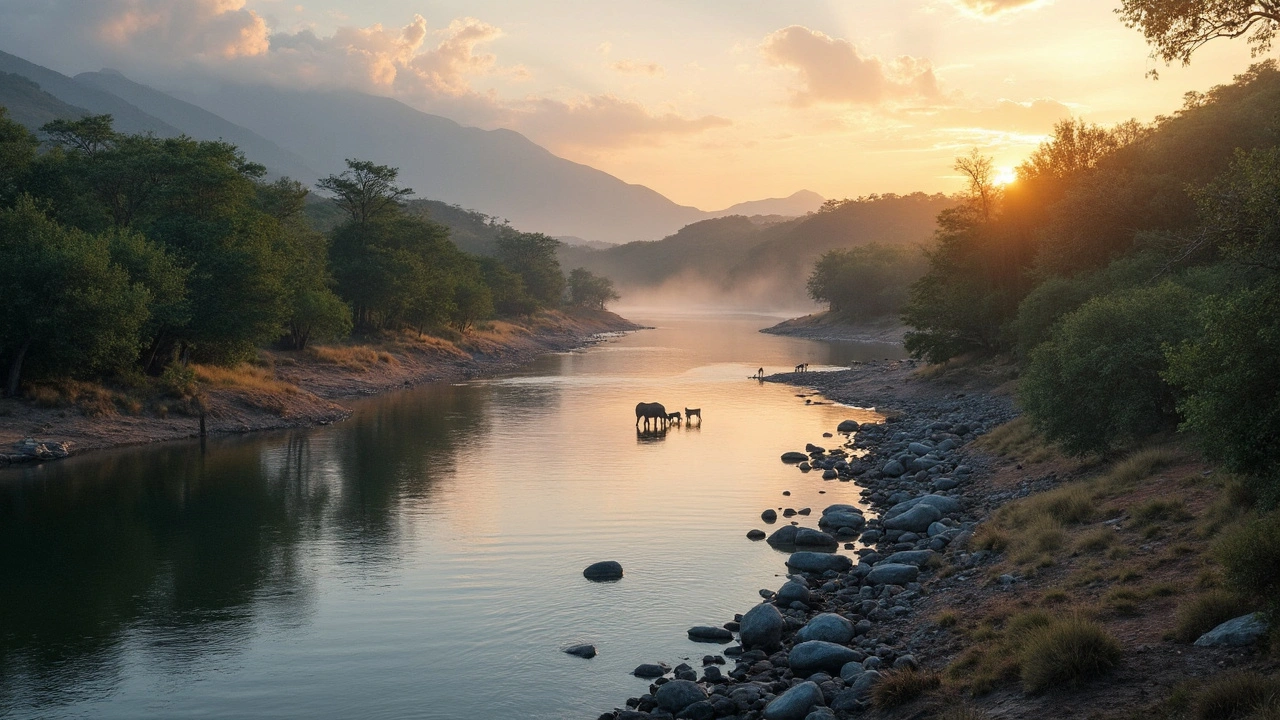
Ever found yourself curious about the Black Umfolozi River? It's one of those hidden gems nestled in the heart of KwaZulu-Natal, South Africa. Originating near Vryheid, this river weaves its way through some of the most stunning landscapes you could imagine. What’s in a name, you ask? Well, the river's allure lies in its signature dark stones and the way it meanders like a piece of modern art through the landscape.
But it's not just a picturesque site; this river holds layers of history. It once defined the eastern limits of the Ndwandwe kingdom, a place steeped in tales as ancient as time. Fast forward to the 1950s, and the river's narrative took a turn with human intervention for agriculture, specifically sugarcane. This meddling led to problematic sediment shifting towards the St. Lucia Estuary, altering its natural flow.
As for what swims beneath its waters? You’ll find species like the scaly yellowfish, a testament to its rich biodiversity. This isn't just about fish, though. The river flows through Hluhluwe-Imfolozi Park, adding to its ecological importance and making it a nature lover's paradise.
- The Journey of the Black Umfolozi
- Historical Significance
- Ecological Challenges
- Diverse Flora and Fauna
- Cultural Impact
- Exploring the Surrounding Regions
The Journey of the Black Umfolozi
Picture this: a river that kicks off its adventure near Vryheid, in a place called KwaMnyathi in South Africa. That's where the Black Umfolozi River begins its journey. From there, it heads southeast, twisting and turning through regions that sound as vibrant as they are, like Swart-Mfolozi, Ceza, and Nongoma. Each of these places has its own charm and local character.
Ever wonder why it got the name Black Umfolozi? Well, it comes from the dark stones you find along its riverbed, combined with its windy, zigzagging path. Can you imagine the beauty of these black stones contrasting with the golden sunrise? It’s picture-perfect for sure. And when it crosses the paths of White Umfolozi River near an area called Hlabisa, they merge to form a larger waterway simply known as the Umfolozi River.
But life around the Black Umfolozi isn't just about picturesque views. It plays a significant role in South Africa's water system, especially since it runs through the well-known Hluhluwe-Imfolozi Park. This park is famous for being a hotspot of biodiversity. Just think of the range of plants and animals that rely on its waters. It’s part of why the river is such a treasure here.
Now, let’s not forget the human touch. Over time, the activities of people, particularly in the 1950s, had quite an impact. Sugarcane farming around this KwaZulu-Natal area caused significant changes in water flow. The river’s sediments got interrupted, influencing areas downstream like the important St. Lucia Estuary. Imagine the pressure this builds on maintaining the delicate ecosystem balance.
The key takeaway? The Black Umfolozi isn’t just a river—it's a tapestry of natural wonders and human history, each part of its journey adding another layer to its story.
Historical Significance
The Black Umfolozi River may seem like just another pretty body of water, but scratch beneath the surface and you’ll find a rich tapestry of history. Back in the day, this river was more than just a geographical landmark. It formed the eastern boundary of the Ndwandwe kingdom, an influential power in Southern Africa.
Ruling during the late 18th and early 19th centuries, the Ndwandwe kingdom was no small fry. They were big players in the region, competing with other powerful tribes like the Zulu. The Black Umfolozi River, by marking territorial limits, held strategic importance. During that time, rivers weren't just bodies of water; they were lifelines, supply routes, and even natural defenses against rivals.
Before European colonization left its mark, these rivers were the highways of ancient Africa, facilitating trade and interaction among different communities. The Ndwandwe, under their formidable leader Zwide, utilized the river not just for its resources, but as a natural barrier against invasion.
The River's Transformations
Fast forward to the mid-20th century, the river saw another shift. Human activity began shaping it anew, particularly with the rise of sugarcane farming in the area. It's fascinating to think that a river that played such a crucial role in historical conflicts is now entwined with agriculture.
The impact of these changes can't be overstated. As the river's flow was altered to serve modern needs, its historical footprint began shifting from battles and boundaries to ecological significance.
Ecological Challenges
When it comes to the Black Umfolozi River, it's no secret that human activities have thrown quite a curveball to its natural flow. Back in the 1950s, things changed when the demand for sugarcane farming skyrocketed. This meant more land had to be prepared for crops, leading to alterations in the river's course. Imagine trying to twist a river's arm; that’s what took place.
So, what exactly happened? By diverting sections of the river to provide irrigation for sugarcane, sediment movement got muddled up. Sediments that usually flowed into the St. Lucia Estuary, crucial for maintaining its ecological balance, ended up stuck, causing sedimentation problems. Over time, this lack of natural sediment flow changed the estuary’s dynamics.
Impact on Local Biodiversity
With sediment levels changing, water quality and habitats for fish and other aquatic life altered too. The beloved scaly yellowfish, along with other marine life, started feeling the pinch. What was once a thriving environment became a challenging place for survival. Biodiversity—both in the water and around—started dwindling.
The situation isn't all gloom and doom, though. Conservation efforts have been stepping up to the plate. Initiatives to restore natural river patterns and rehabilitate the affected estuary zones are underway. The goal? Bring back the delicate balance that once allowed species to thrive here.
Conservation and Future Outlook
What does the future hold for the Black Umfolozi River? With ongoing efforts, we could see a restoration of its natural course, which might help rekindle its ecological vibrance. Imagine seeing those scaly yellowfish thriving again, and hearing stories of renewed biodiversity from locals.
Also, awareness among communities and farmers about sustainable practices is gaining traction, aiming to coexist with nature rather than at its cost. It's a hopeful picture—one that acknowledges past mistakes and strives for a better future.
| Year | Key Event |
|---|---|
| 1950s | Structural changes for sugarcane irrigation |
| 1980s | Increased sedimentation issues observed |
| 2025 | Active restoration projects in place |

Diverse Flora and Fauna
The Black Umfolozi River might not be the biggest river on the map, but when it comes to nature, size doesn’t always matter. This charming waterway is home to a remarkable array of plants and animals. The river winds through the renowned Hluhluwe-Imfolozi Park, creating a lush haven where life flourishes.
Walking along its banks, you might find yourself in awe of the vibrant greenery. The area around the river is dotted with acacias and dense bushveld flora. Their presence provides essential shade, making the riverbanks an attractive spot for wildlife seeking respite from the sun.
Fascinating Wildlife
The waters are teeming with species like the scaly yellowfish, which enjoy the river's diverse habitat. And let's not forget the feathered crowd! Birdwatchers would be thrilled to know that kingfishers and fish eagles can often be seen swooping down for a meal. It's a veritable feast for the senses!
Now, if you're lucky, you might spot some of the park's larger residents too. The river is a lifeline for species such as elephants, rhinos, and buffaloes. These magnificent creatures often come down to the river to drink and cool off — a sight that's pure magic for visitors.
Importance of the Ecosystem
If you’re thinking it's just about the animals, think again. The river’s ecosystem plays a critical role in maintaining the balance. Healthy river systems control their own sediment and nutrient cycling, which in turn supports a range of other plants and animals.
In short, whether you're an avid nature enthusiast or just someone who appreciates the outdoors, the Black Umfolozi River region offers something special. From its smallest critters to its towering trees, this place is a reminder of the intricate web of life that flourishes when left to its own devices.
Cultural Impact
The Black Umfolozi River isn't just a natural wonder; it's a cultural touchstone for the communities that have called its banks home for centuries. Steeped in rich heritage, this river has been an integral part of Zulu folklore and history. It's often said that understanding the rivers of a place can reveal a lot about its people, and that couldn't be truer here.
The river served as a critical boundary line for the Ndwandwe kingdom, marking territories in a time when land was the primary resource. This boundary wasn't just about geographical divisions; it embodied cultural and social distinctions too. Thus, the river carried immense symbolic weight. Zulu historian, Sipho Masondo, once said,
"A river like the Umfolozi isn’t just water flowing; it’s the lifeline and soul of our people's past and present."
Rituals and Traditions
Many Zulu rituals involve the Umfolozi River. Traditional ceremonies, such as umemulo (coming of age), often include a visit to the river’s banks. There's something genuinely profound about these ceremonies being held here, signaling the transition from childhood to adulthood while rooted in cultural legacy. Ceremonies are a common sight, especially during significant community events.
Modern Day Relevance
Even today, local artists and storytellers draw inspiration from this river. It's a common backdrop in South African literature and art. Schools in the region often include visits to the river as part of their curriculum to teach children about local history and ecology. It's not just about history; it's about continuity and keeping traditions alive in a rapidly changing world.
This cultural importance is complemented by the economic role the river has played, historically providing water and resources for agriculture and daily life. But it’s the stories and traditions that have maternally nurtured the cultural spirit of those dwelling nearby, ensuring the river's cultural impact flows through generations.
Exploring the Surrounding Regions
Let’s take a trip around the area surrounding the incredible Black Umfolozi River. There’s more than just natural beauty here; it’s a place packed with culture, wildlife, and adventure. Trust me, you're gonna want to pack your bags after reading this!
Adventures in Hluhluwe-Imfolozi Park
This is a must-visit spot. Why? It's the oldest proclaimed nature reserve in Africa, home to the Big Five: lions, leopards, elephants, rhinos, and buffalos. It's about more than just ticking wildlife off a list. It’s about feeling the heartbeat of Africa as you explore this stunning reserve. Guided safaris are always a win here!
Nongoma’s Cultural Richness
If you’re up for a cultural dive, head over to Nongoma, a town replete with Zulu heritage. It's well-known for its royal residence and vibrant cultural activities. You can even catch some traditional Zulu dance performances and craft markets. Talk about getting immersed in history!
Ceza Cave Adventures
Are you the adventurous type? Try the Ceza Caves. These are more than just rock formations; they are geological wonders that have witnessed centuries pass by. It's perfect for exploring and a treat for those interested in geology.
Vryheid’s Outdoor Fun
Start at Vryheid, where the river begins. This town offers hiking trails like no other. While you're there, scout out Bivane Dam for some laid-back fishing or canoeing. It’s a spot loved by locals and visitors alike.
Seriously, there's so much more to the KZN region than just the river. Whether you're after history, wildlife, or outdoor fun, the surrounding areas are worth the exploration. So, grab your camera and adventurous spirit because this trip will be unforgettable!






Write a comment